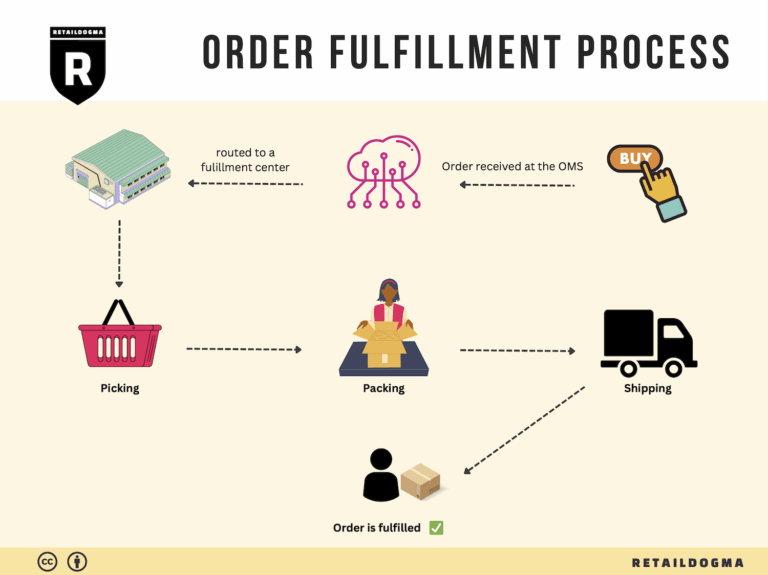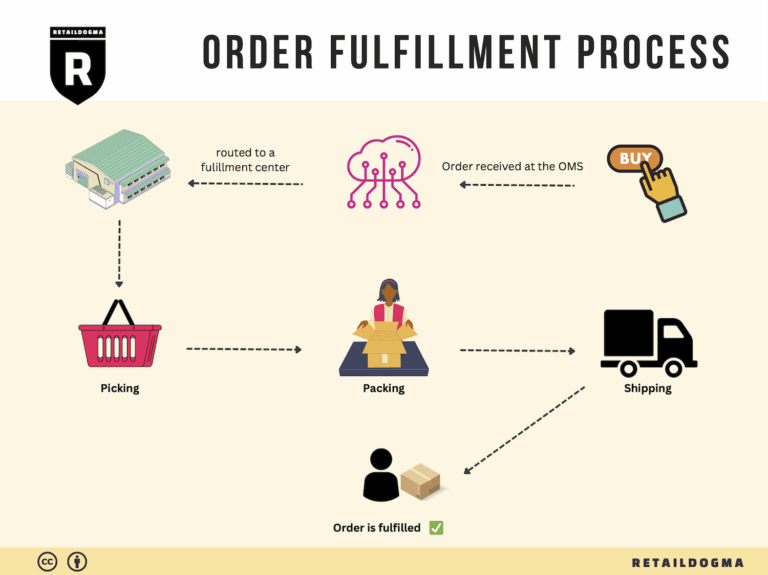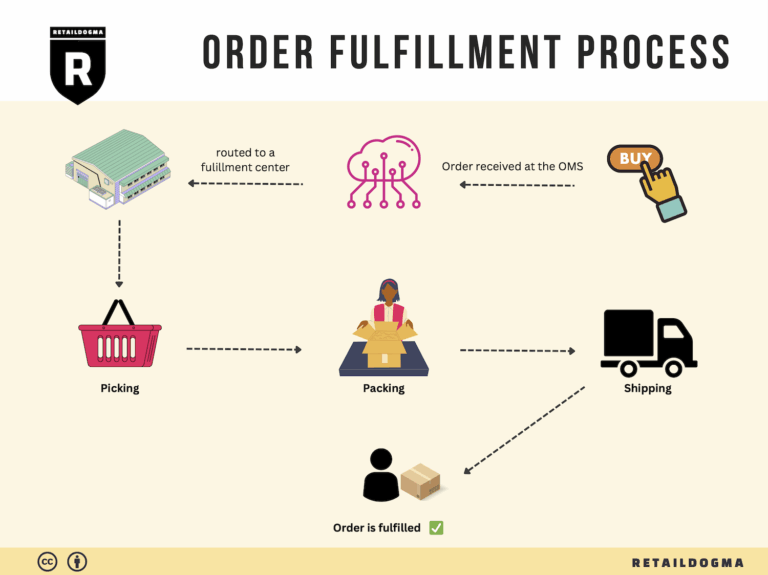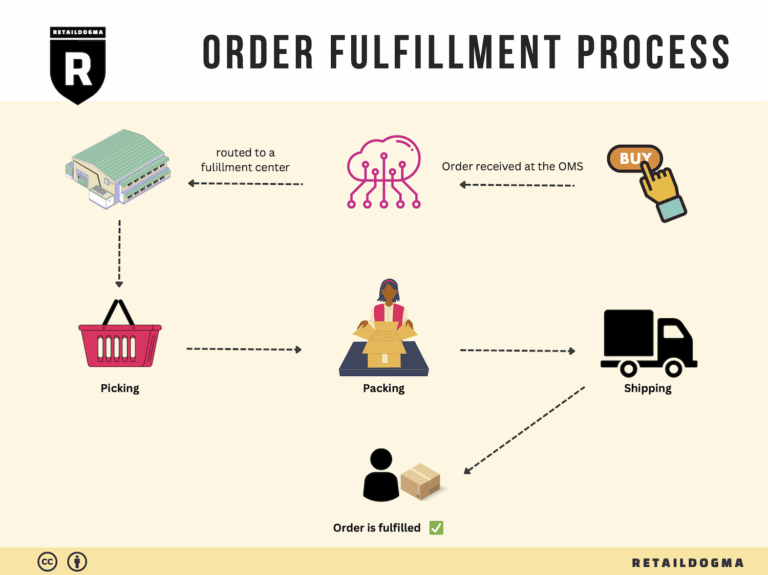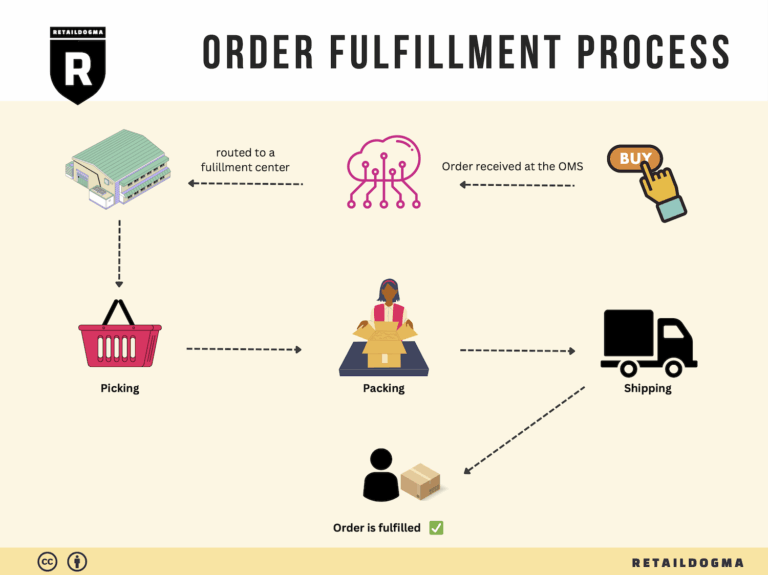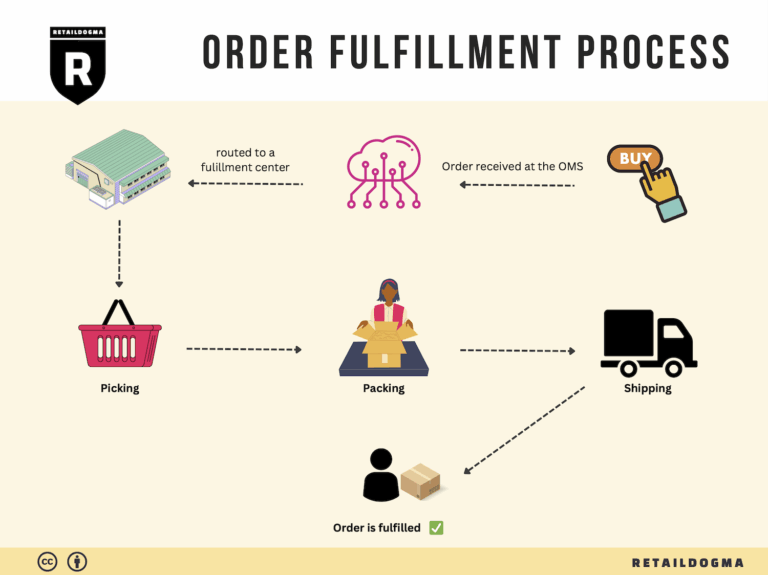How Order Fulfillment Works: A Step-by-Step Guide for Businesses
What is E-commerce Fulfillment? An Introduction for Growing Businesses
Understanding E-commerce Fulfillment
As your e-commerce business begins to flourish, the excitement of increased sales can quickly turn into a daunting challenge—managing the packing and shipping of orders. Many growing online retailers find themselves overwhelmed with the logistics of fulfillment, which can detract from their core focus: providing excellent products and customer experiences. Fulfillment is simply the process of getting a product from your warehouse to your customer’s doorstep, and mastering this process is crucial for sustainable growth.
In this guide, we will demystify e-commerce fulfillment and provide you with actionable insights to streamline your operations. We’ll explore different fulfillment models, including Third-Party Logistics (3PL) and Fulfillment by Amazon (FBA), so you can determine which approach aligns best with your business needs. Understanding these options will help you leverage the strengths of established fulfillment networks while maintaining control over your brand.
We will also delve into the core services that fulfillment partners typically offer, such as inventory management, order processing, packing, and shipping. Each of these services plays a vital role in ensuring that your customers receive their orders promptly and accurately, which is essential for building trust and loyalty.
Choosing the right fulfillment partner can be a game changer for your business. This guide will provide criteria and tips for evaluating potential partners, helping you find a solution that fits your operational requirements and budget. We will also cover pricing structures, so you can make informed decisions that won’t compromise your profitability.
Ultimately, our goal is to empower you with the knowledge needed to make smart decisions about your logistics strategy. By understanding the landscape of e-commerce fulfillment, you can position your business for growth, enhance customer satisfaction, and free up your time to focus on what you do best—growing your brand and serving your customers.
What You’ll Learn In This Guide
- What is E-commerce Fulfillment? An Introduction for Growing Businesses
- The Order Fulfillment Process: From ‘Buy’ Button to Customer’s Door
- Comparing Fulfillment Models: In-House vs. 3PL vs. Dropshipping
- A Deep Dive into Amazon FBA: Pros, Cons, and Who It’s For
- Core Services Offered by Fulfillment Centers
- How to Choose a Fulfillment Partner: A 6-Point Checklist
- Understanding Fulfillment Pricing: A Breakdown of Common Fees
- Frequently Asked Questions (FAQs) about Fulfillment
- Conclusion: Is Outsourcing Fulfillment the Right Move for Your Business?
- Important Disclaimer
The Order Fulfillment Process: From ‘Buy’ Button to Customer’s Door
1. Receiving Inventory
The order fulfillment process begins with the receiving inventory stage, where products arrive at the fulfillment center from sellers. This step is crucial as it sets the foundation for efficient order processing. Upon arrival, each item is unloaded and inspected to ensure it matches the purchase order. Employees or automated systems then scan each product using a unique identifier, typically a Stock Keeping Unit (SKU), to log it into the inventory management system.
This step is vital because accurate receiving minimizes discrepancies between what is expected and what is actually delivered. Any errors at this stage can lead to delays and inefficiencies later in the process. Effective receiving procedures also ensure that the inventory levels are accurately reflected, which is essential for maintaining customer satisfaction and preventing stockouts.
2. Warehouse Storage
Once items are received, they move to the warehouse storage phase. Here, products are organized and stored using advanced inventory management techniques. One popular method employed by Amazon is chaotic storage, where items are placed in any available space rather than being grouped by category. This approach maximizes storage efficiency and speeds up the retrieval process.
Efficient storage is critical for several reasons. It allows the fulfillment center to optimize space, which is particularly important given the high volume of inventory. Moreover, having a well-organized storage system facilitates faster order picking, as workers or robots can quickly locate and retrieve items. The use of real-time tracking systems ensures that the inventory is always up-to-date, reducing the chances of errors when orders are processed.
3. Order Picking
The next step is order picking, where the fulfillment center prepares items for shipment based on customer orders. When a customer clicks the ‘Buy’ button, the system generates a pick list, which outlines the specific items and quantities needed for each order. Fulfillment centers often utilize a combination of human workers and robots to execute this step efficiently.
Order picking is a pivotal part of the fulfillment process because it directly affects delivery speed and accuracy. The efficiency of this stage can be enhanced through technologies such as automated guided vehicles (AGVs) and robotic arms that assist with picking. By optimizing the picking process, businesses can significantly reduce lead times, which is crucial for maintaining competitiveness in the e-commerce landscape.
4. Order Packing
After items are picked, they enter the order packing phase. During packing, items are carefully placed into appropriate packaging to ensure they arrive at the customer’s door in perfect condition. Advanced algorithms determine the optimal box size for each order, minimizing waste and reducing shipping costs.
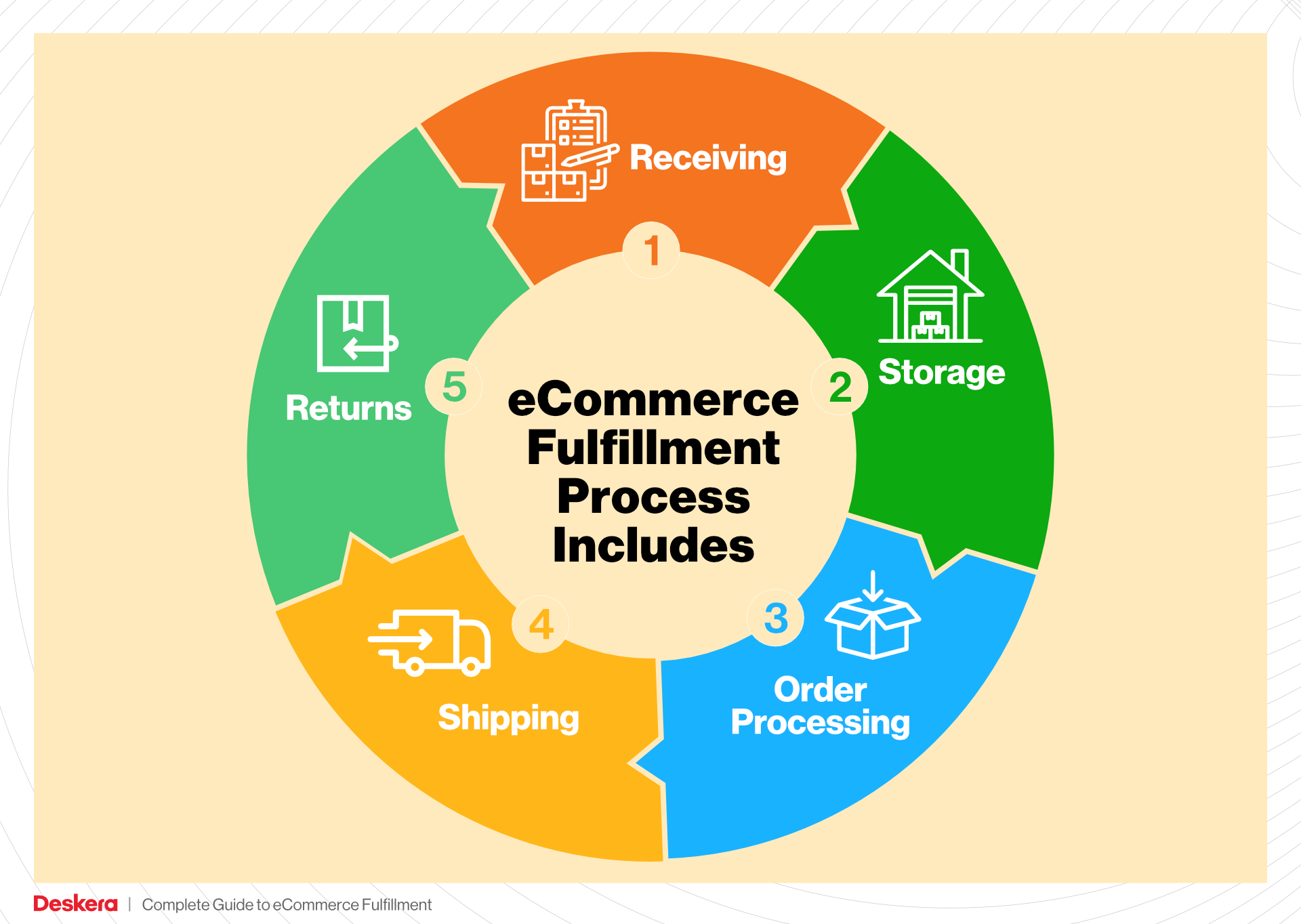
This step is essential for customer satisfaction and operational efficiency. Proper packing protects the products during transit and helps to prevent returns due to damage. Additionally, efficient packing processes contribute to faster shipping times, as items can be prepared for delivery more quickly. Businesses should invest in training employees on best packing practices and consider automation where feasible to streamline this stage.
5. Shipping & Delivery
The final step in the order fulfillment process is shipping and delivery. Once packed, packages are labeled and sent out for delivery, often through partnerships with various shipping carriers. Fulfillment centers coordinate closely with these carriers to ensure that packages reach customers as quickly as possible.
This stage is crucial for customer satisfaction as it directly influences delivery times. Efficient shipping processes can enable businesses to offer expedited services, such as same-day or next-day delivery, which have become expected in today’s e-commerce environment. Additionally, tracking systems allow customers to monitor their packages in real-time, enhancing the overall shopping experience. Investing in robust logistics partnerships and technologies can greatly improve the efficiency of shipping and delivery operations.
By understanding and optimizing each of these five steps in the order fulfillment process, e-commerce businesses can enhance their operational efficiency, improve customer satisfaction, and ultimately scale their operations successfully.
Comparing Fulfillment Models: In-House vs. 3PL vs. Dropshipping
Fulfillment Model Comparison
| Model | Who Handles Inventory | Best For (Business Stage) | Key Advantage | Key Disadvantage |
|---|---|---|---|---|
| In-House Fulfillment | Business itself | Established businesses | Greater control over inventory and processes | High overhead costs and operational complexity |
| Third-Party Logistics (3PL) | Third-party provider | Growing businesses | Scalability and reduced operational burden | Less control over inventory management |
| Dropshipping | Supplier | Startups or niche markets | Low upfront investment and risk | Lower profit margins and reliance on suppliers |
In-House Fulfillment
In-house fulfillment refers to the practice where a business manages its own warehousing, inventory, and shipping processes. This model is particularly beneficial for established businesses that have a stable demand and can afford the infrastructure costs associated with maintaining a fulfillment center. The key advantage of in-house fulfillment lies in the control it offers; businesses can directly oversee inventory management, quality control, and the entire shipping process. This level of oversight can lead to enhanced customer satisfaction, as products are handled according to the company’s specific standards and protocols. However, managing fulfillment in-house can also come with significant drawbacks. The overhead costs associated with warehousing, staffing, and technology can be substantial, especially for smaller businesses. Additionally, as order volumes fluctuate, operational complexities can increase, making it challenging to maintain efficiency and cost-effectiveness.
Third-Party Logistics (3PL)
Third-party logistics (3PL) involves outsourcing logistics and fulfillment operations to a specialized provider. This model is ideal for growing businesses that need to scale their operations without the heavy burden of managing logistics in-house. A 3PL provider typically handles inventory storage, order processing, shipping, and sometimes even returns management. The primary advantage of using a 3PL is scalability; businesses can quickly adapt to changes in demand without the need for significant investments in infrastructure. Additionally, 3PL providers often have established relationships with shipping carriers, which can lead to cost savings and improved shipping times. However, businesses that choose this model may face challenges in terms of control over inventory management and fulfillment processes. Relying on a third-party provider means that businesses must trust their partner to maintain quality and accuracy in fulfilling orders, which can be a concern if the 3PL does not meet the expected service levels.
Dropshipping
Dropshipping is a fulfillment model where the retailer does not hold inventory but instead transfers customer orders and shipment details to a manufacturer or supplier, who then ships the products directly to the customer. This model is particularly well-suited for startups or businesses exploring niche markets, as it requires minimal upfront investment and reduces the financial risks associated with holding inventory. The key advantage of dropshipping is the low barrier to entry; businesses can start selling products without the need for warehousing or upfront inventory costs. Additionally, it allows for a broad product offering since retailers can easily add new items to their catalog without worrying about stock management. However, dropshipping also comes with significant disadvantages, including lower profit margins, as retailers often pay a premium for convenience. Furthermore, reliance on suppliers can lead to issues with inventory availability, shipping times, and quality control, which can ultimately impact customer satisfaction.
Conclusion
When choosing a fulfillment model, e-commerce business owners must carefully consider their current stage, financial resources, and operational goals. Each model—whether in-house fulfillment, 3PL, or dropshipping—offers unique advantages and disadvantages that can significantly impact business performance. By understanding these models’ intricacies, entrepreneurs can make informed decisions that align with their growth strategies and customer expectations. As businesses scale, they may even find that a hybrid approach—combining elements from multiple models—best suits their evolving needs.
A Deep Dive into Amazon FBA: Pros, Cons, and Who It’s For
Understanding Fulfillment by Amazon (FBA)
Fulfillment by Amazon (FBA) is a service that allows e-commerce sellers to store their products in Amazon’s fulfillment centers. Amazon takes care of storage, packaging, and shipping, along with customer service and returns. This system leverages Amazon’s vast logistics network and customer trust to help sellers reach a broader audience without the overhead of managing their own fulfillment operations.
How FBA Works
-
Product Listing and Inventory Setup: Sellers begin by creating product listings on Amazon. They can either create new listings or add their products to existing ones. Once the listings are set up, sellers send their inventory to Amazon’s fulfillment centers.
-
Storage: Products are stored in Amazon’s warehouses, where they are organized using sophisticated inventory management systems. This allows Amazon to quickly locate items when orders are placed.
-
Order Processing: When a customer places an order for a product fulfilled by Amazon, the system automatically directs the nearest fulfillment center with the item in stock to pick, pack, and ship the product.
-
Shipping and Delivery: Amazon handles all aspects of shipping, including delivery and tracking. Products fulfilled through FBA are eligible for Amazon Prime, which provides expedited shipping options.
-
Customer Service and Returns: Amazon also manages customer inquiries, complaints, and returns, offering a streamlined experience for both sellers and customers.
Pros of FBA
1. Prime Eligibility
Products fulfilled by Amazon are automatically eligible for Prime, which can significantly increase visibility and sales. Prime members are known for their higher spending habits, and offering Prime shipping can make products more attractive to a broader audience.
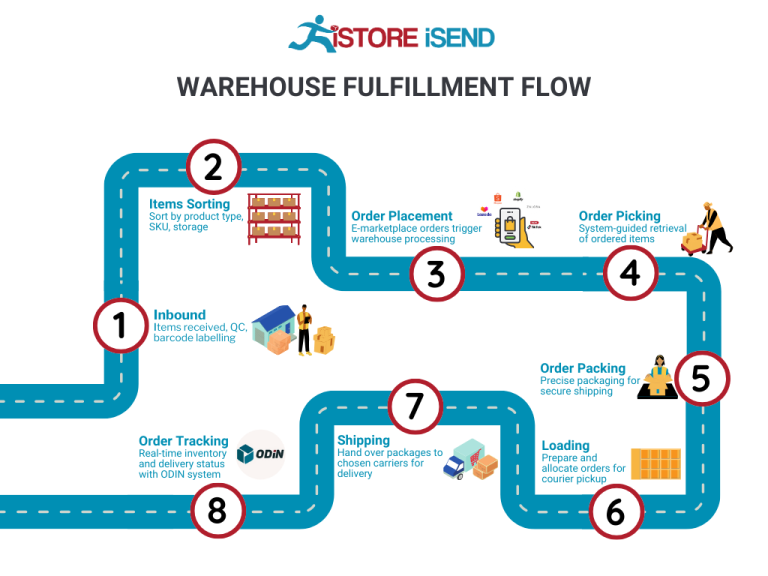
2. Enhanced Customer Trust
Using FBA enhances customer trust and credibility. Amazon’s brand reputation for reliability and fast shipping reflects positively on sellers. Customers are more likely to purchase from products that are fulfilled by Amazon due to the assurance of quality service.
3. Multi-Channel Fulfillment
FBA isn’t limited to Amazon sales. Sellers can use FBA to fulfill orders from their own websites or other sales channels, thereby streamlining their logistics across multiple platforms. This flexibility allows businesses to expand their reach without managing separate inventory systems.
4. Simplified Logistics
FBA simplifies the logistics of running an e-commerce business. Sellers don’t need to worry about warehousing, packing, or shipping, allowing them to focus on other critical aspects of their business, such as marketing and product development.
5. Access to Amazon’s Advanced Technology
Sellers benefit from Amazon’s sophisticated inventory management systems, which include real-time tracking, predictive analytics, and efficient order processing. This can lead to reduced operational costs and improved efficiency.
Cons of FBA
1. High Fees
While FBA offers numerous benefits, it does come with associated costs. Amazon charges storage fees for the space used in their fulfillment centers and fulfillment fees based on the size and weight of the items. These fees can add up quickly, particularly for sellers with low-margin products.
2. Strict Inventory Rules
Amazon has stringent guidelines regarding inventory management. Sellers must adhere to specific requirements for packaging, labeling, and shipping their products to fulfillment centers. Non-compliance can result in additional fees or the refusal of inventory.
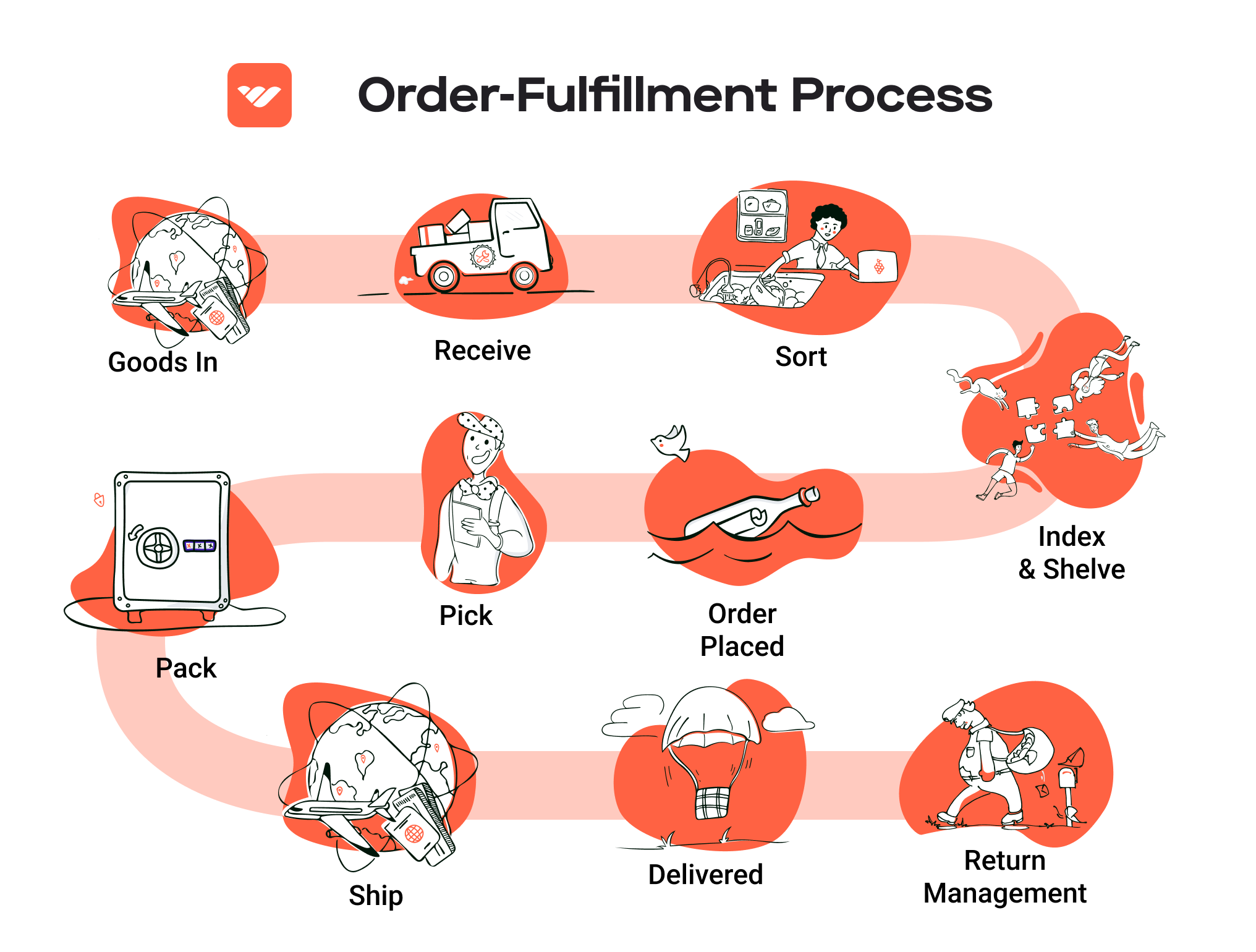
3. Commingling Risks
FBA products are often commingled, meaning that sellers’ products can be stored alongside those of other sellers. This can lead to issues if a customer receives a damaged or defective item that is not theirs. Additionally, it complicates tracking inventory and returns.
4. Limited Control
Sellers relinquish a degree of control over their inventory and fulfillment processes. This can be challenging for businesses that prefer to have direct oversight of their operations. Any errors or delays in Amazon’s system can directly affect a seller’s reputation.
5. Seasonal Variability
During peak shopping seasons, such as the holidays, fulfillment centers can become overcrowded, leading to increased storage fees and potential delays in shipping. Sellers must plan their inventory carefully to avoid complications during these busy periods.
Who is FBA Best For?
Fulfillment by Amazon is particularly well-suited for:
-
Small to Medium-Sized Sellers: Businesses that may not have the resources to manage their own logistics can benefit significantly from FBA’s streamlined processes.
-
Sellers with High-Volume Products: Those who sell popular or high-demand items can leverage FBA to scale rapidly without the burden of managing logistics themselves.
-
E-commerce Entrepreneurs Looking for Growth: New sellers who want to quickly establish their presence on Amazon and capitalize on the platform’s customer base will find FBA advantageous.
-
Multi-Channel Retailers: Businesses that sell across various platforms can use FBA to simplify their fulfillment, allowing them to maintain a single inventory system for multiple sales channels.
In conclusion, while FBA offers numerous advantages such as increased visibility, customer trust, and simplified logistics, it also presents challenges like high fees and limited control. Sellers must carefully weigh these factors to determine if FBA aligns with their business goals and operational capabilities. For many, the benefits outweigh the drawbacks, making FBA an attractive option for scaling e-commerce businesses.
Core Services Offered by Fulfillment Centers
Inventory Management & Warehousing
Inventory management and warehousing are fundamental services provided by fulfillment centers. This involves the systematic storage and tracking of products from various sellers. Fulfillment centers utilize advanced inventory management systems that offer real-time tracking of stock levels, ensuring that businesses have a clear view of their inventory at all times.
The benefit of effective inventory management is twofold. Firstly, it minimizes the risk of stockouts or overstock situations, which can tie up capital and increase storage costs. By employing sophisticated algorithms and predictive analytics, fulfillment centers can forecast demand more accurately, allowing businesses to optimize their inventory levels. Secondly, efficient warehousing operations ensure that products are stored strategically, enabling faster retrieval during the order fulfillment process. This is particularly crucial during peak seasons, where demand can spike unexpectedly.
Pick and Pack Services
Pick and pack services represent a critical component of the order fulfillment process. When a customer places an order, fulfillment centers efficiently pick the ordered items from the warehouse shelves and prepare them for shipment. This process is often supported by advanced technology, such as automated picking systems and robotics, which enhance speed and accuracy.
The primary benefit of pick and pack services is the reduction in order processing time, which directly impacts customer satisfaction. In an age where consumers expect quick delivery times, being able to process orders rapidly can give e-commerce businesses a competitive edge. Furthermore, fulfillment centers typically employ rigorous quality control measures during the packing process, ensuring that the right products are shipped and minimizing the risk of returns due to errors. This level of precision not only enhances customer trust but also reduces the costs associated with returns and re-shipments.
Kitting and Assembly
Kitting and assembly services allow businesses to streamline their product offerings by combining multiple items into a single package or kit. This service is particularly beneficial for companies that sell complementary products or bundles. For example, a kitchenware company may offer a bundle that includes pots, pans, and utensils packaged together for convenience.
The advantage of kitting and assembly is that it simplifies the purchasing process for customers, thereby increasing the average order value. Additionally, fulfillment centers can handle the labor-intensive task of assembling kits, freeing up e-commerce businesses to focus on core activities such as marketing and product development. This service also allows for more efficient shipping, as bundled products can be shipped in a single package, reducing shipping costs and enhancing the customer experience.
Returns Management (Reverse Logistics)
Returns management, or reverse logistics, is a critical service offered by fulfillment centers that often goes overlooked. This process involves handling returned items efficiently and effectively, including inspecting, restocking, and processing refunds or exchanges. Given that e-commerce businesses can experience return rates as high as 30% in some sectors, managing this process is essential for maintaining profitability.
The key benefit of a well-structured returns management system is that it enhances customer satisfaction and loyalty. Customers are more likely to shop with a brand that offers a hassle-free return process. Fulfillment centers streamline this process by quickly assessing returns, determining whether items can be restocked or need to be discarded, and efficiently processing refunds. Additionally, effective returns management can provide valuable insights into product quality and customer preferences, allowing businesses to make informed decisions regarding inventory and product offerings.
In conclusion, fulfillment centers provide a suite of core services that are essential for scaling e-commerce operations. By leveraging inventory management and warehousing, pick and pack services, kitting and assembly, and returns management, businesses can enhance efficiency, reduce costs, and ultimately improve customer satisfaction. As e-commerce continues to grow, the role of fulfillment centers in supporting these operations will only become more vital.
How to Choose a Fulfillment Partner: A 6-Point Checklist
Location & Warehouse Network
Importance: The location of your fulfillment partner’s warehouses can significantly impact shipping times and costs. A strategically located partner can help you reach your customers faster, enhancing their experience and potentially increasing repeat business.
Questions to Ask:
– How many fulfillment centers do you operate, and where are they located?
– What is the average shipping time to major customer demographics in our target market?
– Can you accommodate international shipping, and if so, what are the logistics involved?
Technology & Integrations
Importance: A fulfillment partner’s technology capabilities can streamline your operations, enhance order accuracy, and provide real-time inventory tracking. Seamless integration with your existing e-commerce platform is critical for operational efficiency.
Questions to Ask:
– What warehouse management system (WMS) do you use, and how does it integrate with platforms like Shopify, Amazon, or WooCommerce?
– Can you provide real-time tracking for orders, and how is this information shared with us and our customers?
– Do you offer API access for custom integrations, and what support is available for technical issues?
Specializations (e.g., Cold Storage, Oversized Items)
Importance: Different products require different handling and storage solutions. If your business involves specialized items, such as perishable goods or oversized products, it’s essential to partner with a fulfillment center that has the right capabilities.
Questions to Ask:
– Do you have specialized facilities for items that require temperature control or hazardous materials?
– How do you handle oversized or heavy items, and what are the associated costs?
– Can you accommodate seasonal products or fluctuating inventory levels, and how would that be managed?
Scalability & Capacity
Importance: As your business grows, your fulfillment partner must be able to scale with you. Understanding their capacity and flexibility is crucial to avoid disruptions in service during peak periods.
Questions to Ask:
– What is your current capacity, and how do you manage seasonal fluctuations in order volume?
– Can you provide examples of how you have supported other clients through periods of rapid growth?
– What contingency plans do you have in place in case of unexpected demand spikes or operational challenges?
Pricing and Contracts
Importance: Transparent pricing structures and flexible contracts are essential to maintain profitability while ensuring that you receive the services you need. Understanding the cost implications of various services is critical for budgeting.
Questions to Ask:
– Can you provide a detailed breakdown of your pricing model, including storage fees, pick and pack costs, and shipping rates?
– Are there any hidden fees that we should be aware of, such as for returns processing or seasonal storage?
– What are the terms of your contracts, and is there flexibility for renegotiation as our business needs change?
Customer Support & Reviews
Importance: Quality customer support can make a significant difference in your day-to-day operations. A responsive and knowledgeable support team can help resolve issues quickly, minimizing downtime and enhancing your customer experience.
Questions to Ask:
– What type of customer support do you offer (e.g., phone, email, live chat), and what are your typical response times?
– Can you provide references or case studies from other clients in our industry?
– How do you handle disputes or issues that arise during the fulfillment process, and what is your escalation procedure?
Conclusion
Choosing the right fulfillment partner is a critical decision that can influence your e-commerce success. By using this checklist, you can systematically evaluate potential partners based on essential criteria, ensuring that you select one that aligns with your business goals and customer expectations.
Understanding Fulfillment Pricing: A Breakdown of Common Fees
Initial Setup Fees
Initial setup fees are often the first cost that e-commerce businesses encounter when engaging with a fulfillment provider. These fees typically cover the administrative and technical aspects of onboarding your products into the fulfillment system. This can include creating your account, integrating your e-commerce platform with the fulfillment provider’s systems, and establishing inventory management protocols.
The calculation of initial setup fees can vary significantly based on the complexity of the integration and the number of products being onboarded. For instance, a business with a straightforward catalog may incur lower fees compared to a company with a large, diverse inventory requiring extensive categorization and configuration. It’s essential to clarify what is included in these fees, as some providers may offer a tiered pricing model based on the level of service and support required during the setup phase.
Receiving Fees
Receiving fees are charged when products arrive at the fulfillment center and are checked into inventory. This fee compensates the fulfillment center for the labor and resources required to unload, inspect, and log items into their inventory management system.
Typically, receiving fees are calculated per item or per pallet received. For example, a fulfillment provider may charge a flat rate for the first 100 items received, with a reduced rate for any additional items. Understanding the specifics of these fees is crucial, especially for businesses that anticipate high volumes of incoming inventory. Some providers may also have minimum charges, so it’s wise to confirm these details upfront to avoid unexpected costs.
Storage Fees (per pallet/bin)
Storage fees are recurring charges associated with the space your inventory occupies within the fulfillment center. These fees can be structured on a per-pallet or per-bin basis, depending on how the provider organizes their storage.
The calculation of storage fees typically involves assessing the total cubic space your products occupy. Businesses with larger, bulkier items may face higher fees than those with smaller products that can be stored more efficiently. Additionally, many fulfillment centers implement tiered pricing based on the amount of space used; for instance, the first few pallets might be charged at a standard rate, while excess pallets incur a higher rate. It’s essential to evaluate your inventory turnover rate as well since businesses with slow-moving stock may find storage fees accumulating quickly.
Pick & Pack Fees (per item/order)
Pick and pack fees are charged for the labor involved in retrieving items from inventory and packaging them for shipment. This fee structure can vary widely based on the provider, with some charging per item picked, while others may charge a flat fee per order regardless of the number of items.
For example, a fulfillment provider may charge $1.00 per item picked and an additional $2.00 for packing. Understanding how these fees are calculated is critical, as businesses with complex orders or numerous SKUs can see costs escalate quickly. Additionally, some providers offer volume discounts or bundled services, which can help reduce overall pick and pack expenses. It’s advisable to analyze your average order size and frequency to accurately estimate these costs.
Shipping Fees
Shipping fees encompass the costs associated with transporting products from the fulfillment center to the customer’s doorstep. These fees can vary based on factors such as package weight, dimensions, destination, and the shipping method selected (standard, expedited, etc.).
Shipping fees are typically calculated based on carrier rates, which can fluctuate based on market conditions. Many fulfillment centers partner with multiple carriers to provide competitive shipping options. Understanding the shipping options available and their associated costs is crucial for budgeting and maintaining competitive pricing for your customers. Additionally, some providers may offer discounted shipping rates, which can significantly affect your overall fulfillment costs.
Tips for Getting an Accurate Quote
-
Provide Detailed Information: When seeking quotes, be as detailed as possible about your inventory, order volume, and shipping needs. This information will help fulfillment providers give you a more accurate estimate.
-
Ask About Additional Fees: Inquire about any potential additional fees that may not be included in the initial quote, such as returns processing or special handling.
-
Evaluate Your Needs: Assess your business model and inventory turnover to select a fulfillment provider that aligns with your operational requirements.
-
Negotiate Terms: Don’t hesitate to negotiate pricing, especially if you can commit to a long-term partnership or anticipate high volumes.
-
Request a Trial Period: If possible, negotiate a trial period to evaluate the fulfillment provider’s services and pricing structure before committing long-term.
By understanding these common fulfillment pricing models and carefully evaluating your options, you can make informed decisions that align with your business goals and help you scale effectively.
Frequently Asked Questions (FAQs) about Fulfillment
1. What is the role of Amazon fulfillment employees?
Amazon fulfillment employees are responsible for managing various tasks within fulfillment centers, including receiving and inspecting products, storing items, picking orders, packing products for shipping, and handling returns. Their efforts ensure that orders are processed efficiently and accurately, contributing to Amazon’s reputation for fast delivery.
2. How do Amazon fulfillment centers differ from traditional warehouses?
Amazon fulfillment centers are designed for high-volume, rapid order processing, focusing on e-commerce logistics. Unlike traditional warehouses, which may prioritize long-term storage, fulfillment centers utilize advanced technology and automation to manage inventory and expedite the shipping process, allowing for faster delivery to customers.
3. What technologies are employed in Amazon fulfillment centers?
Amazon fulfillment centers leverage a range of technologies, including robotics (like Kiva robots for item retrieval), automated conveyor systems, advanced inventory management systems, and real-time tracking software. These innovations enhance operational efficiency and accuracy, enabling the processing of millions of orders each day.
4. What is a third-party logistics provider (3PL)?
A third-party logistics provider (3PL) is a company that offers outsourced logistics services to businesses. This can include warehousing, order fulfillment, transportation, and inventory management. Using a 3PL can help e-commerce businesses scale their operations without the need to invest in their own fulfillment infrastructure.
5. How much do fulfillment services cost?
The cost of fulfillment services can vary widely based on factors such as the volume of orders, types of products, storage space needed, and specific services required (like packaging or kitting). Businesses typically pay for warehousing space, per-order processing fees, shipping costs, and sometimes additional service charges. It’s advisable to obtain quotes from multiple fulfillment providers to understand potential costs.
6. What skills are important for Amazon fulfillment employees?
Key skills for Amazon fulfillment employees include attention to detail, physical stamina, familiarity with technology (such as scanners and inventory management systems), teamwork, and the ability to work in a fast-paced environment. These skills are critical for ensuring accurate order fulfillment and maintaining operational efficiency.
7. How does Amazon ensure employee safety in fulfillment centers?
Amazon prioritizes employee safety by implementing rigorous safety protocols, including regular training, ergonomic assessments, and the use of personal protective equipment (PPE). Fulfillment centers are equipped with safety equipment, and employees are encouraged to report hazards or unsafe practices.
8. What are the benefits of working at an Amazon fulfillment center?
Benefits for Amazon fulfillment employees often include competitive wages, health insurance, retirement plans, employee discounts, and opportunities for career advancement. Additionally, Amazon has initiatives aimed at fostering a diverse and inclusive work environment.
9. How does Amazon handle returns in fulfillment centers?
Returns are processed in dedicated areas within fulfillment centers. Employees inspect returned items, determine their condition, and restock or discard them as appropriate. Efficient return handling is crucial for maintaining customer satisfaction and managing inventory effectively.
10. What is the future of fulfillment centers at Amazon?
The future of Amazon fulfillment centers is likely to involve increased automation, further integration of AI and machine learning for inventory management, and sustainability initiatives. As e-commerce continues to grow, Amazon will likely expand its fulfillment network to enhance delivery speeds and improve customer experience while embracing innovative technologies to streamline operations.
Conclusion: Is Outsourcing Fulfillment the Right Move for Your Business?
Evaluating the Benefits of Outsourcing Fulfillment
Outsourcing your fulfillment process can be a game-changer for your e-commerce business. By leveraging a fulfillment service, you can save valuable time that can be redirected towards core business activities such as marketing, product development, and customer engagement. This time savings can significantly enhance your operational efficiency, allowing you to focus on scaling your business rather than getting bogged down in logistics.
Scalability is another critical advantage. As your business grows, so do the complexities of managing inventory, processing orders, and shipping products. A proficient fulfillment partner can seamlessly accommodate increased order volumes without the need for you to invest in additional infrastructure or staff. This flexibility enables you to respond to market demands swiftly and maintain high service levels, which are crucial for customer satisfaction and retention.
Moreover, fulfillment services bring a wealth of expertise to the table. These partners are equipped with advanced technology, industry knowledge, and best practices that can optimize your supply chain. From inventory management systems to automated packing processes, their proficiency can lead to improved accuracy, reduced shipping times, and lower costs.
However, it is imperative to choose the right fulfillment partner to ensure that your business goals align with their capabilities. Evaluate potential partners based on their technology, service offerings, and track record. A well-chosen partner can drive significant growth and enhance your overall customer experience.
Take Action
To determine if outsourcing fulfillment is the right move for your business, conduct a thorough audit of your current shipping processes. Assess your time expenditures, costs, and customer satisfaction levels. This evaluation will provide valuable insights into whether a fulfillment partner could streamline your operations and support your growth ambitions. Don’t hesitate to explore your options—your next strategic step could be just a decision away.
Important Disclaimer
⚠️ Important Disclaimer
The information in this guide is for educational purposes. Fulfillment services, pricing, and platform features change frequently. Always conduct your own due diligence and consult with providers directly before making business decisions.

